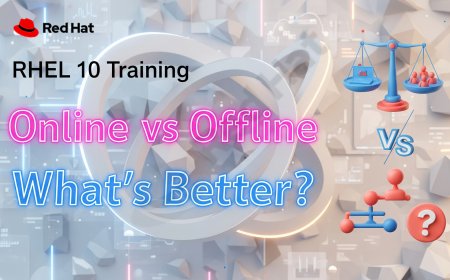ISRO's Cybersecurity Measures | A Closer Look
The Indian Space Research Organisation (ISRO) stands as a symbol of national pride and technological prowess. From the successful Chandrayaan missions to the ambitious Gaganyaan program, ISRO has cemented India's place among the world's leading space-faring nations. But behind every successful launch and every piece of data transmitted from space lies a silent, continuous battle: the fight against cyber threats. In an era where space assets are integral to national security, communication, and economic stability, the cybersecurity of organizations like ISRO is of paramount importance. A cyberattack on a space agency could have catastrophic consequences, from disrupting a mission in progress to compromising sensitive data and technology. This blog post takes a deep dive into the robust cybersecurity framework that protects ISRO's missions and assets, exploring the unique challenges of space cybersecurity and the comprehensive strategies the organization employs to safeguard its operations in the final frontier.

Table of Contents
- Introduction
- The Unique Cyber Threats to ISRO
- A Multi-Layered Defense Strategy
- The Role of Technology and Innovation
- Supply Chain and the Human Element
- ISRO as a National Asset and a Global Player
- Conclusion
- Frequently Asked Questions (FAQs)
The Unique Cyber Threats to ISRO
ISRO faces a unique set of cyber challenges that go beyond those of a typical corporation. Its assets are dispersed across the globe and in orbit, creating an extensive attack surface. The threats are not just from common cybercriminals but from sophisticated state-sponsored actors, seeking to gain a strategic advantage or steal valuable intellectual property. The potential targets include:
- Mission Control Centers: The brains of any mission, these centers are highly coveted targets. An attack could lead to the hijacking of a satellite, the disruption of a launch, or the compromise of critical mission data.
- Satellite and Payload Systems: Hacking into a satellite's onboard systems could render it useless or even turn it into a weapon.
- Data Links: The communication channels between ground stations and satellites are susceptible to jamming, spoofing, and data interception.
- Research and Development Networks: ISRO’s networks contain decades of sensitive research on propulsion, satellite design, and new technologies. This makes them a prime target for industrial espionage.
The consequences of a successful cyberattack would not only be a national embarrassment but could also severely impact India's security and economic interests. This understanding drives ISRO's comprehensive and proactive approach to cybersecurity.
A Multi-Layered Defense Strategy
ISRO's cybersecurity strategy is not a single tool or a simple firewall; it’s a multi-layered, integrated approach that protects every segment of its space ecosystem. This strategy operates on three primary fronts: the ground, the space, and the communication links that connect them.
Ground Segment Security: The First Line of Defense
The ground segment, which includes ISRO's various centers, launchpads, and mission control facilities, is the most accessible part of the system for an attacker. ISRO has fortified this segment with a range of advanced measures:
- Network Segmentation: Critical networks are isolated from less secure ones. For example, the network used for mission control is entirely separate from the general administrative network, creating an air gap that prevents easy lateral movement for an attacker.
- Access Control: Strict access control policies are in place, limiting who can access sensitive data and systems. This includes strong authentication protocols and the principle of least privilege, ensuring employees only have access to what is absolutely necessary for their job.
- Intrusion Detection and Prevention Systems (IDPS): ISRO's networks are monitored 24/7 by IDPS, which detect and block malicious activity in real-time.
- Physical Security: The physical security of ground facilities is paramount. Strict controls on who can enter and exit these facilities prevent unauthorized access to crucial hardware and servers.
Space Segment Security: Hardening the Assets in Orbit
Satellites themselves are increasingly being equipped with cybersecurity measures. Once a satellite is in orbit, physically patching or updating it is extremely difficult, making it crucial to "bake in" security from the design phase. ISRO's satellites are designed with:
- Strong Encryption: All data transmitted from the satellite, including telecommands and telemetry, is encrypted to prevent interception and manipulation.
- Secure Boot Mechanisms: Satellites are designed to boot up from a trusted source, preventing an attacker from loading malicious firmware or software onto the system.
- Onboard Cybersecurity: Some satellites are being equipped with a limited form of onboard cybersecurity, capable of detecting and responding to anomalies or suspicious commands independently of the ground station.
This "secure by design" philosophy ensures that the space assets are as resilient as possible from the moment they are launched.
Link Segment Security: Securing the Communication Channels
The communication link between the ground and space is the lifeline of any mission. ISRO employs sophisticated measures to secure this link against jamming, spoofing, and interception:
- Advanced Cryptography: The communication is protected using advanced cryptographic algorithms. This ensures that even if an attacker intercepts the signal, the data remains unreadable.
- Spread Spectrum Technology: To prevent jamming, ISRO uses spread spectrum technology, which makes the signal more difficult to disrupt. It works by spreading the signal over a wide range of frequencies, making it harder for an attacker to block.
- Authentication Protocols: Strong authentication protocols are used to verify the legitimacy of commands sent to the satellite. This ensures that only authorized signals from ISRO's ground stations can control the spacecraft.
The Role of Technology and Innovation
ISRO's cybersecurity is a dynamic field that continuously evolves to counter new threats. The organization leverages cutting-edge technology and innovation to stay ahead of adversaries:
- Cyber Threat Intelligence: ISRO constantly monitors for new cyber threats and vulnerabilities, and a dedicated team analyzes intelligence to predict and prepare for potential attacks.
- Collaboration with Indian Institutions: ISRO works closely with academic institutions and research labs in India to develop new cybersecurity technologies and train a new generation of experts.
- Adoption of AI and Machine Learning: The organization is exploring the use of AI and machine learning for real-time threat detection and anomaly analysis, allowing for faster and more automated responses to a security incident.
This commitment to innovation ensures that ISRO's cybersecurity posture is not static but a living, breathing defense system.
Supply Chain and the Human Element
A crucial and often overlooked aspect of cybersecurity is the supply chain. ISRO, like any major space agency, relies on a vast network of vendors and contractors for components and software. A vulnerability introduced at any point in this chain could be a backdoor for an attacker. ISRO addresses this by:
- Vetting and Auditing Suppliers: Rigorous vetting and regular security audits of all suppliers and vendors ensure that all components and software are free of malicious code.
- Secure Development Practices: ISRO promotes secure development practices among its contractors, encouraging them to build security into their products from the start.
The human element is equally critical. ISRO's personnel, from engineers to administrative staff, are the first line of defense. The organization invests heavily in regular and comprehensive cybersecurity awareness training. This training covers everything from recognizing phishing emails to following secure protocol, ensuring that every employee understands their role in protecting the organization's assets.
ISRO as a National Asset and a Global Player
The security of ISRO is not just an organizational concern; it is a matter of national security. The data from ISRO's remote sensing and communication satellites is crucial for military intelligence, disaster management, and a wide range of civilian applications. A successful cyberattack could disrupt these services, with profound consequences for the nation. ISRO's robust cybersecurity measures are a testament to India's commitment to protecting its space assets and maintaining its strategic autonomy in this critical domain. As India’s role in the global space economy grows, ISRO’s cybersecurity framework will be a model for others, showcasing how a nation can build a resilient and secure space program.
Table: ISRO's Cybersecurity Pillars
| Pillar | Key Focus | Example Measures |
|---|---|---|
| Ground Segment | Securing terrestrial infrastructure. | Network segmentation, strict physical access control, intrusion detection systems. |
| Space Segment | Protecting assets in orbit. | Secure boot mechanisms, onboard encryption, secure design. |
| Link Segment | Safeguarding communication channels. | Advanced cryptography, spread spectrum technology, command authentication. |
| Supply Chain | Ensuring vendor security. | Rigorous vetting, security audits, secure development practices. |
| Human Element | Raising staff awareness. | Regular cybersecurity training, simulated phishing exercises. |
Conclusion
ISRO’s cybersecurity measures are a reflection of its commitment to excellence and national security. The organization understands that in the digital age, a nation's strength in space is as much about its cybersecurity as it is about its rocket technology. By adopting a multi-layered, integrated approach that protects every part of its space ecosystem—from the ground to the satellites in orbit—ISRO has built a robust and resilient defense against a constantly evolving threat landscape. The focus on technology, supply chain security, and the human element ensures that ISRO is not just a leader in space exploration but also a pioneer in securing the final frontier. As the world becomes more reliant on space-based services, ISRO’s proactive and comprehensive approach will serve as a valuable blueprint for others, ensuring a secure and prosperous future in space for all.
Frequently Asked Questions (FAQs)
Why is ISRO a target for cyberattacks?
ISRO is a prime target because it holds a wealth of sensitive information and intellectual property related to space technology. Attacks could be motivated by a desire to steal technology, disrupt missions, or gain a strategic advantage over India.
What is "network segmentation" and why is it important for ISRO?
Network segmentation involves dividing a network into smaller, isolated segments. This is crucial for ISRO because it prevents an attacker who breaches a less critical network from gaining access to highly sensitive mission-critical systems.
What are the main segments of a space system that ISRO secures?
ISRO's cybersecurity focuses on three main segments: the **Ground Segment** (terrestrial facilities), the **Space Segment** (the satellites themselves), and the **Link Segment** (the communication channels between them).
What is a "supply chain attack" in the context of ISRO?
A supply chain attack is when an attacker compromises a component or software from a third-party vendor before it is integrated into ISRO's systems. This could introduce a backdoor or vulnerability that is very difficult to detect.
How does ISRO prevent an attacker from sending commands to a satellite?
ISRO uses strong authentication protocols that verify the legitimacy of every command sent to a satellite. This ensures that only authorized ground stations can communicate with and control the spacecraft.
Is it possible to physically damage a satellite with a cyberattack?
A cyberattack can't physically destroy a satellite in a traditional sense, but it can be used to hijack a satellite's control systems and make it maneuver in a way that causes a collision with another object or leads to its deorbiting, effectively rendering it useless.
What is "secure by design"?
Secure by design is an approach that involves integrating cybersecurity measures into a system from the very beginning of its design and development, rather than adding them on as an afterthought. For ISRO, this means building security directly into its satellite hardware and software.
How does ISRO protect its communication from jamming?
ISRO uses advanced techniques like **spread spectrum technology**, which spreads the communication signal over a wide range of frequencies, making it much harder for an adversary to jam or disrupt the signal.
What is the role of the human element in ISRO's cybersecurity?
The human element is the first line of defense. ISRO personnel, from engineers to administrators, are regularly trained to recognize and report cyber threats, like phishing emails or suspicious activity, to prevent human error from leading to a security breach.
What kind of data does ISRO need to protect?
ISRO needs to protect a wide range of data, including mission plans, satellite design blueprints, telemetry data from spacecraft, and sensitive information from research and development, all of which are highly valuable to adversaries.
Does ISRO work with other organizations on cybersecurity?
Yes, ISRO collaborates with various academic and research institutions in India to develop new cybersecurity technologies and talent. This partnership helps them stay ahead of emerging threats.
What happens if a cyberattack is successful?
If a cyberattack were to succeed, the consequences could include mission failure, loss of a satellite, theft of sensitive data, or disruption of critical national services that rely on ISRO’s assets.
Why is physical security so important for ISRO's cybersecurity?
Physical security, like strict access controls, prevents an attacker from gaining direct access to ISRO's servers and hardware. A breach in physical security could bypass all digital security measures, making it a critical component of the overall defense strategy.
How does ISRO address supply chain vulnerabilities?
ISRO has a rigorous process for vetting and auditing its suppliers and vendors. This ensures that all components and software used in its missions are trustworthy and free of malicious code.
What is the difference between a cyberattack on a satellite and an anti-satellite (ASAT) weapon?
An ASAT weapon is a kinetic weapon that physically destroys a satellite, creating space debris. A cyberattack is a non-kinetic attack that uses software and network vulnerabilities to disable or hijack a satellite without causing physical damage, though it can still make the satellite unusable.
Is it harder to secure a satellite than a regular computer network?
Yes, it's significantly harder. Once a satellite is in space, it's extremely difficult to physically access it for repairs or updates. This means that all security measures must be "baked in" from the start and be highly resilient to any potential threats.
What is "telemetry" and why does it need to be secure?
Telemetry is the data sent from a spacecraft to a ground station, which includes information about its health, position, and status. It needs to be secure to prevent an adversary from intercepting it to gain intelligence or from manipulating it to cause mission failure.
Does ISRO use Artificial Intelligence (AI) in its cybersecurity?
ISRO is actively exploring the use of AI and machine learning to enhance its cybersecurity. These technologies can help in real-time threat detection and anomaly analysis, allowing for faster and more automated responses to a security incident.
What is an "air gap" in network security?
An air gap is a security measure that physically isolates a secure computer network from all other external networks, including the internet. This is a very high level of security used for ISRO's most critical systems.
How does ISRO’s cybersecurity contribute to national security?
ISRO’s robust cybersecurity protects its assets that are vital for national security, including satellites used for military surveillance, intelligence gathering, and secure communication. It ensures that India can maintain its strategic autonomy in the space domain.
What's Your Reaction?
 Like
0
Like
0
 Dislike
0
Dislike
0
 Love
0
Love
0
 Funny
0
Funny
0
 Angry
0
Angry
0
 Sad
0
Sad
0
 Wow
0
Wow
0















